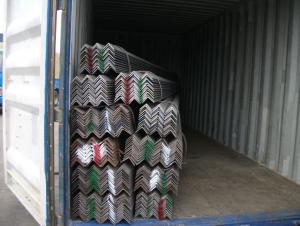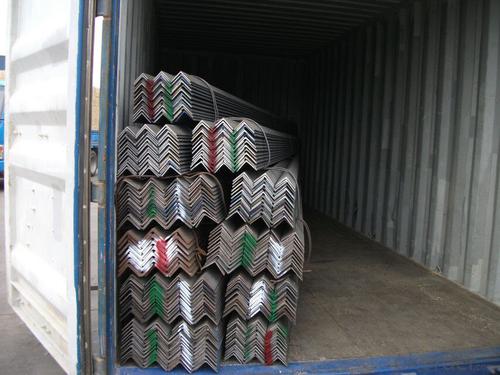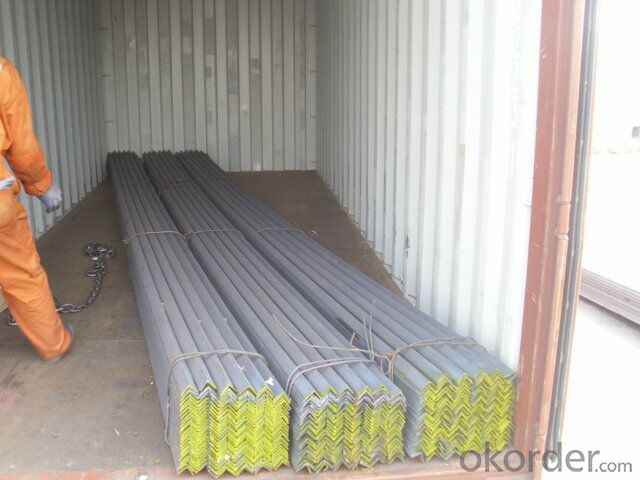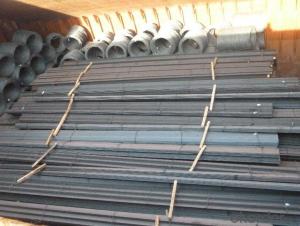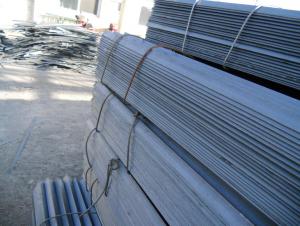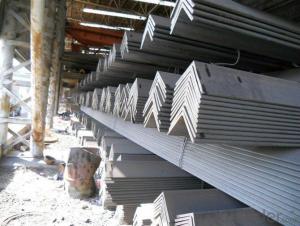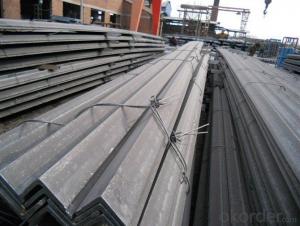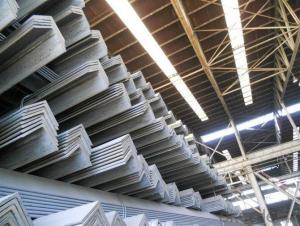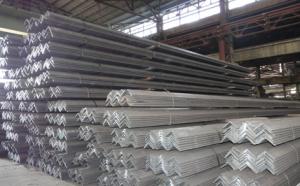Wholesale 2015 Hot Rolled Angle Steel inLarge Stock
- Loading Port:
- Tianjin
- Payment Terms:
- TT OR LC
- Min Order Qty:
- 25 m.t.
- Supply Capability:
- 20000 m.t./month
OKorder Service Pledge
OKorder Financial Service
You Might Also Like
Specification
OKorder is offering high quality Hot Rolled Steel Angle at great prices with worldwide shipping. Our supplier is a world-class manufacturer of steel, with our products utilized the world over. OKorder annually supplies products to European, North American and Asian markets. We provide quotations within 24 hours of receiving an inquiry and guarantee competitive prices.
Product Applications:
Hot Rolled Steel Angles are ideal for structural applications and are widely used in the construction of buildings and bridges, and the manufacturing, petrochemical, and transportation industries.
Product Advantages:
OKorder's Steel Angles are durable, strong, and resist corrosion.
Main Product Features:
· Premium quality
· Prompt delivery & seaworthy packing (30 days after receiving deposit)
· Corrosion resistance
· Can be recycled and reused
· Mill test certification
· Professional Service
· Competitive pricing
Product Specifications:
Manufacture: Hot rolled
Grade: Q195 – 235
Certificates: ISO, SGS, BV, CIQ
Length: 6m – 12m, as per customer request
Packaging: Export packing, nude packing, bundled
Sizes: 25mm-250mm | ||
a*t | ||
25*2.5-4.0 | 70*6.0-9.0 | 130*9.0-15 |
30*2.5-6.6 | 75*6.0-9.0 | 140*10-14 |
36*3.0-5.0 | 80*5.0-10 | 150*10-20 |
38*2.3-6.0 | 90*7.0-10 | 160*10-16 |
40*3.0-5.0 | 100*6.0-12 | 175*12-15 |
45*4.0-6.0 | 110*8.0-10 | 180*12-18 |
50*4.0-6.0 | 120*6.0-15 | 200*14-25 |
60*4.0-8.0 | 125*8.0-14 | 250*25 |
FAQ:
Q1: Why buy Materials & Equipment from OKorder.com?
A1: All products offered byOKorder.com are carefully selected from China's most reliable manufacturing enterprises. Through its ISO certifications, OKorder.com adheres to the highest standards and a commitment to supply chain safety and customer satisfaction.
Q2: How do we guarantee the quality of our products?
A2: We have established an advanced quality management system which conducts strict quality tests at every step, from raw materials to the final product. At the same time, we provide extensive follow-up service assurances as required.
Q3: How soon can we receive the product after purchase?
A3: Within three days of placing an order, we will begin production. The specific shipping date is dependent upon international and government factors, but is typically 7 to 10 workdays.
Alloy No | Grade | Element (%) | |||||
C | Mn | S | P | Si | |||
Q235 | B | 0.12—0.20 | 0.3—0.7 | ≤0.045 | ≤0.045 | ≤0.3 | |
Alloy No | Grade | Yielding strength point( Mpa) | |||||
Thickness (mm) | |||||||
≤16 | >16--40 | >40--60 | >60--100 | ||||
≥ | |||||||
Q235 | B | 235 | 225 | 215 | 205 | ||
Alloy No | Grade | Tensile strength (Mpa) | Elongation after fracture (%) | ||||
Thickness (mm) | |||||||
≤16 | >16--40 | >40--60 | >60--100 | ||||
≥ | |||||||
Q235 | B | 375--500 | 26 | 25 | 24 | 23 | |
Images:
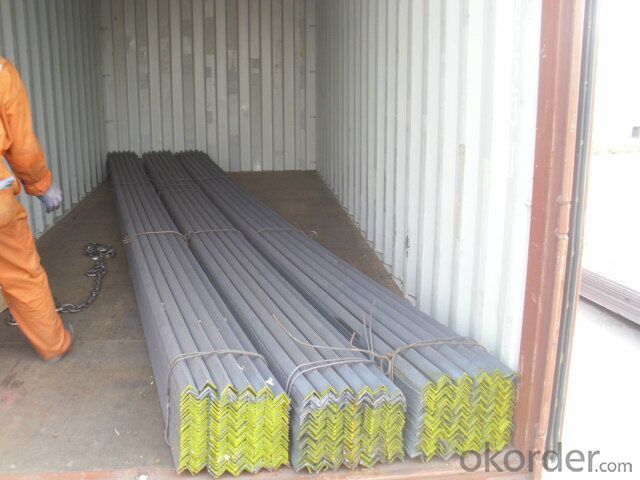
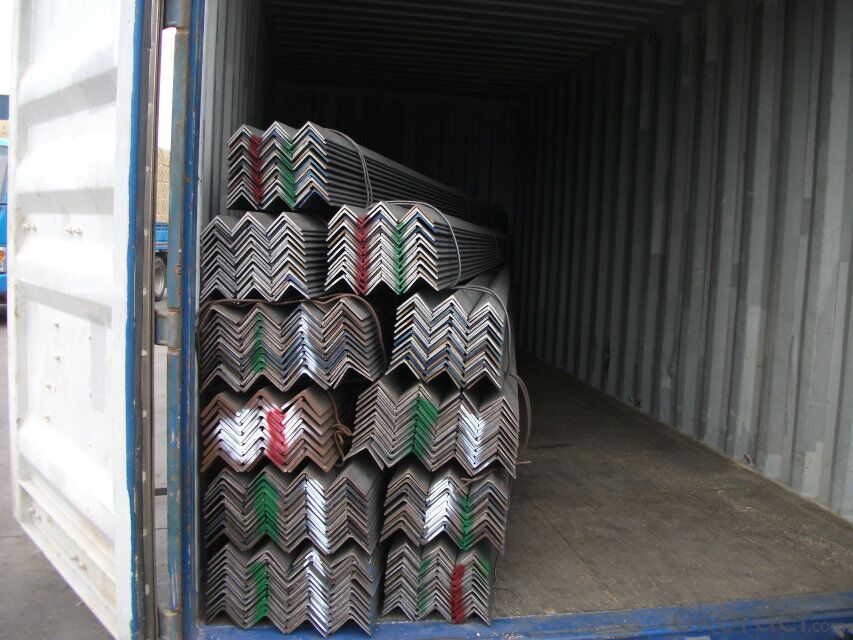
- Q: Can steel angles be used in the construction of parking garages?
- Yes, steel angles can be used in the construction of parking garages. Steel angles are commonly used as structural components in various construction applications, including parking garages. They provide strength, stability, and support for the overall structure and can be used for framing, bracing, and reinforcing. Steel angles are versatile and can be easily customized to meet the specific design requirements of parking garage construction.
- Q: Can steel angles be used in the construction of staircases?
- Yes, steel angles can be used in the construction of staircases. Steel angles provide structural support and stability, making them a suitable choice for building staircases.
- Q: What is the typical thickness of the base of a steel angle?
- The base thickness of a steel angle can vary depending on its specific application and requirements. Typically, the base thickness of a steel angle ranges from 1/8 inch to 3/8 inch. It is worth mentioning that this range is not comprehensive, and there may be instances where the base thickness deviates from these parameters. Elements such as the steel angle's size, load-bearing capacity, and intended purpose will impact the necessary base thickness for a particular project or structure. As a result, consulting engineering specifications or seeking professional guidance is crucial in determining the suitable base thickness for a steel angle in a specific application.
- Q: What are the different types of connections used for steel angles in structural applications?
- Steel angles in structural applications can be connected using various types of connections. These connections play a crucial role in maintaining the stability and strength of the overall structure. Firstly, welded connections are commonly used. This method involves fusing the edges of the steel angles together through melting, resulting in a strong bond. Welded connections are ideal for applications that require high strength and rigidity. Secondly, bolted connections provide flexibility as they involve using bolts and nuts to secure the steel angles. This type of connection allows for easy disassembly and reassembly if needed. Bolted connections are often chosen for their ease of installation and maintenance. Thirdly, riveted connections are a traditional method of joining steel angles. This involves inserting a rivet through holes in the steel angles and flaring the ends to secure them. Although riveted connections are known for their durability and resistance to corrosion, they are less commonly used today due to the time-consuming installation process. Next, clip connections utilize metal clips or brackets to attach the steel angles quickly and efficiently. These clips can be welded or bolted to the angles, making them suitable for applications where speed and ease of installation are important. Lastly, gusset plate connections involve using steel plates to connect the steel angles at their intersection points. These plates are typically welded or bolted to the angles, enhancing the strength and stability of the connection. Gusset plate connections are often employed when larger forces and moments need to be transferred. It is essential to consider the specific needs of the structure, including the structural requirements, loadings, and the intended application, when choosing the appropriate connection method. Adhering to design and engineering specifications ensures that the selected connection method is suitable for the desired use in structural applications.
- Q: What is the standard length of a steel angle?
- The specific requirements and industry or project standards can lead to variations in the standard length of a steel angle. Typically, steel angles are readily accessible in standard lengths of 20 feet or 6 meters. These standard lengths facilitate transportation, handling, and installation. Nevertheless, it is worth mentioning that custom lengths can also be manufactured to fulfill project-specific requirements.
- Q: What are the different types of connections used with steel angles?
- Steel angles can be connected in various ways, depending on the specific needs of the structure. Here are some of the most commonly used connection types: 1. Welded Connection: A popular choice involves welding the angle to another steel member, like a beam or column, using different welding techniques. This connection provides excellent strength and stability. 2. Bolted Connection: Another option is to use bolts and nuts to secure the steel angle to another component. This type of connection allows for easy disassembly and offers flexibility in adjusting or replacing components. Bolted connections are often preferred when future modifications or repairs may be necessary. 3. Riveted Connection: While not as common today, riveted connections were widely used in the past. They involve using rivets to join the steel angle to other components. Riveted connections offer high strength and durability but require specialized skills and equipment for installation. 4. Gusset Plate Connection: In certain cases, a gusset plate can be employed to connect steel angles. This flat plate is typically bolted or welded to the angle and the other component, providing additional strength and stability. 5. Moment Connection: A specialized type of connection called a moment connection is used to transfer bending moments between steel angles and other components, such as beams or columns. Moment connections are designed to handle significant loads and enhance structural integrity. In conclusion, the choice of connection type depends on factors like load requirements, structural design, ease of installation, and potential for future modifications. Each type of connection has its advantages and limitations, and the appropriate connection type is determined by a structural engineer based on specific project requirements.
- Q: Can steel angles be used in the construction of religious institutions?
- Certainly, religious institutions can utilize steel angles in their construction projects. Given their strength, versatility, and durability, steel angles are widely employed in various construction endeavors. They not only provide structural support but can also be applied in framing, roofing, and reinforcing, among other applications. In the context of erecting religious institutions, steel angles can serve as the foundation for walls, roofs, and floors, while also lending support to architectural elements like domes or spires. Moreover, steel angles can be easily fabricated and tailored to meet specific design specifications. In summary, the use of steel angles in constructing religious institutions ensures the resilience and longevity of the edifice, while allowing for artistic ingenuity and adaptability.
- Q: What are the different methods for protecting steel angles from corrosion?
- There are several methods available for protecting steel angles from corrosion. 1. Galvanization: Galvanization is a widely used method where a layer of zinc is applied to the surface of the steel angle. This zinc layer acts as a sacrificial anode, meaning it corrodes first before the steel, protecting it from rust. This method provides excellent protection and is commonly used in outdoor applications such as construction and infrastructure. 2. Paint coating: Applying a paint coating to the steel angle can provide an effective barrier against corrosion. The paint forms a protective layer that prevents moisture and oxygen from reaching the steel surface, thus inhibiting the corrosion process. It is important to use high-quality, corrosion-resistant paints for long-term protection. 3. Powder coating: Powder coating involves applying a dry powder to the steel angle which is then cured at high temperatures. This creates a hard, durable, and protective layer on the surface. Powder coating provides an attractive finish and excellent resistance to corrosion, making it suitable for both indoor and outdoor applications. 4. Stainless steel: Using stainless steel angles is another method for protecting against corrosion. Stainless steel contains chromium, which forms a passive oxide layer on the surface that acts as a protective barrier against corrosion. This makes stainless steel highly resistant to rust, making it ideal for applications where corrosion is a concern. 5. Cathodic protection: Cathodic protection is a technique used to protect steel angles by making them the cathode in a corrosion cell. This is achieved by connecting the steel angle to a sacrificial anode, such as zinc or aluminum, or by using impressed current systems. By doing so, the anode corrodes instead of the steel, effectively protecting it from corrosion. It is worth noting that the selection of the appropriate method for protecting steel angles from corrosion depends on various factors such as the intended application, environmental conditions, and budget constraints. Consulting with corrosion experts and considering the specific requirements of the project is advisable to ensure the most suitable method is chosen.
- Q: What is the cost of steel angles compared to other materials?
- The cost of steel angles compared to other materials can vary depending on various factors such as the type and grade of steel, market conditions, and availability. However, in general, steel angles tend to be a cost-effective option when compared to other materials commonly used for structural or construction purposes. Steel angles are widely used in various industries including construction, manufacturing, and infrastructure due to their durability, strength, and versatility. Compared to materials like aluminum or stainless steel, steel angles are often more affordable. This is because steel is a widely available material and can be produced in large quantities, leading to cost efficiencies in manufacturing processes. Additionally, steel angles have a long lifespan and require minimal maintenance, further contributing to their cost-effectiveness over time. They also offer excellent load-bearing capabilities, making them suitable for a wide range of applications, including building frames, support structures, and machinery. However, it is important to note that the cost of steel angles can still vary depending on the specific requirements and specifications of a project. Factors such as size, length, thickness, and any additional treatments or finishes can influence the price. Therefore, it is advisable to consult with suppliers or manufacturers to obtain accurate and up-to-date pricing information based on individual project needs.
- Q: How do you calculate the moment of inertia of a steel angle?
- In order to determine the moment of inertia of a steel angle, it is necessary to have knowledge of the angle's dimensions and shape. The moment of inertia is a measurement of an object's resistance to rotational changes and is crucial in the fields of engineering and physics. The moment of inertia, designated as I, can be computed using the following equation: I = (b * h^3) / 12 In this equation: - I represents the moment of inertia - b corresponds to the base width of the steel angle - h denotes the height or leg length of the steel angle This equation assumes that the steel angle is a uniform and solid entity. If the steel angle possesses varying dimensions or contains holes, the calculation becomes more intricate and may necessitate additional formulas or numerical methods. It should be emphasized that the moment of inertia is dependent on the axis of rotation. The aforementioned equation calculates the moment of inertia with respect to the centroidal axis, which is the axis that passes through the angle's center of mass. If the moment of inertia needs to be determined for a different axis, the parallel axis theorem or other advanced techniques may need to be employed. In practical applications, it is often beneficial to consult engineering handbooks or reference materials specifically tailored to steel angles. These resources may offer more comprehensive formulas or tables that consider specific design characteristics and dimensions.
Send your message to us
Wholesale 2015 Hot Rolled Angle Steel inLarge Stock
- Loading Port:
- Tianjin
- Payment Terms:
- TT OR LC
- Min Order Qty:
- 25 m.t.
- Supply Capability:
- 20000 m.t./month
OKorder Service Pledge
OKorder Financial Service
Similar products
Hot products
Hot Searches
Related keywords
